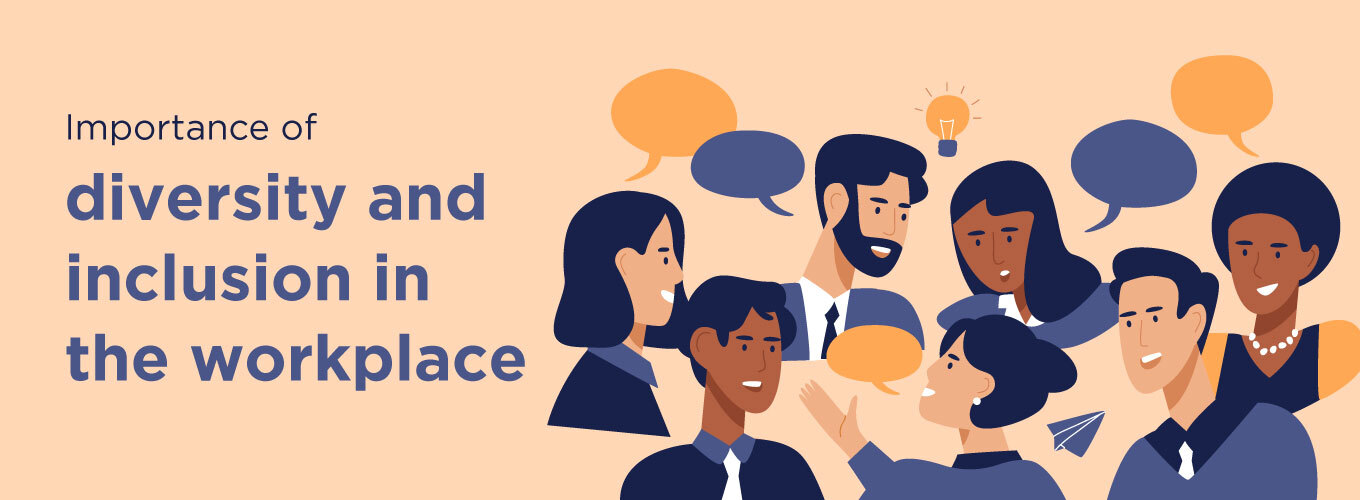Importance of diversity and inclusion in the workplace
Today’s workplaces require a beautiful balance of voices and diversity of thought thanks to diversity and inclusion. Many companies are still struggling with finding this balance which can be achieved only by having people from diverse backgrounds bringing their unique voices to play. It is important that everyone is heard and everyone is given an equal opportunity.
Diversity and Inclusion (D&I) is not about policies or programs. It is about respecting the unique needs, perspectives and potential of every team member. Doing this can build an equitable workplace and help give your company a competitive edge over competitors.
It is important to understand the difference between diversity and inclusion as concepts.
Diversity refers to the differences in political beliefs, race, culture, sexual orientation, religion, class and gender identity. Anyone bringing new thought, backgrounds and perspectives is bringing diversity to the table.
Inclusion means that anyone with a diverse orientation feels respected, valued, involved and treated fairly irrespective of their background in an organization. It is important to recognize talent and empower employees if you want to be an inclusive workplace.
Not respecting D&I issues can lead to a toxic work culture. Focusing only on diversity without inclusion will make people feel out of place and vice-versa too. Focusing on diversity without taking cognizance of inclusion is called “tokenism”. It is not enough to just include people from diverse backgrounds but more important to make them feel empowered, valued and trusted by the business. There needs to be a synergistic approach of both diversity and inclusion to make people feel supported. A diverse workplace is one where everyone irrespective of their background or what they do feel equally involved and supported in all areas.
Workplaces benefit greatly by focusing on D&I. The importance and some of the benefits are as discussed below:
Higher innovation and creativity
Having people from different backgrounds, skills and experiences fosters an increase in creative and innovative ideas. People must feel comfortable sharing their ideas and expressing themselves. Businesses can use these diverse and unique voices and ideas to benefit them and resolve problems easily. Diverse teams can better identify and service the needs of customers. This is because people from diverse backgrounds have faced and overcome several challenges in their life which helps them to develop excellent problem-solving skills.
Improved performance and happiness
Better D&I implementation leads to better performances, which directly impacts business profitability and revenues. Greater D&I also means that employees are happier and hence they work better. When employees thrive in their jobs and roles, businesses will perform extremely well. Teamwork will increase productivity. Increased productivity means better exchange of ideas. People working in diverse workplaces also tend to have better physical and mental health. This enhances productivity.
Increased employee engagement and trust
When employees feel included, they are more engaged. Engaged employees always go the extra mile for the organization. A better engagement means better profitability, better team morale and better retention. There is also better trust between employees and leadership. When leaders recognize the unique talents of their team members and reward them appropriately, it leads to better trust within the team. In an inclusive culture, all employees need to recognize each other.
Better decision-making
Diverse teams make better decisions. Diversity in geography, gender and age enable better decisions in teams than individuals could ever envision. Including employees in the decision-making process is the hallmark of a great organization. Seeking minority voices can help you learn about the issues that people from diverse backgrounds face. Leaders gain new perspectives this way and inspire employees to make a difference.
How to beat challenges of diversity and inclusion
D&I initiatives must align with the company’s goals and values. Top management must allocate time and resources to D&I initiatives. This will convince employees that the organization is serious about these issues. Asking the right questions and tough conversations are important to facilitate true change in D&I. Leaders must objectively assess how D&I can be improved and communicate why to everyone. A D&I-centric work culture needs to be sustained and nurtured by individual managers and HR. They must be trained to understand and implement the D&I-related policies and practices. HR and managers must together present a unified face that upholds D&I practices.
The company’s progress towards D&I goals must constantly be measured, tracked and showcased. Just doing annual surveys will not help. What is required is continuous listening and getting insight into what employees are thinking and feeling. Team leads must be trained to pick up how D&I is manifesting in terms of employee experience. Feedback from them can be used to incorporate people-centric initiatives that can foster a better work environment. Employees must be given a chance to voice concerns on D&I.
It is important to measure D&I-related KPIs. KPIs with regard to diversity are easier to set when compared to those of inclusion. This is because inclusion means equitable employment practices, integration of differences and inclusion of decision making. It also includes measuring the employees’ sense of belonging and authenticity.
While managers and leaders must lead the way, teams must get trained to avoid bias and build an inclusive team. Breaking down silos and increasing communication will strengthen D&I throughout your organization.
Takeaway
There are a myriad ways to improve D&I in your organization. Frequent rewards and recognition programs, building employee resource groups and continuous feedback platforms to gather feedback from employees are all tools to help better D&I practices. D&I must be incorporated into the hiring processes, policies, procedures and compensation and benefits. Companies that maintain their commitment to D&I will continue to thrive and lead the marketplace.









